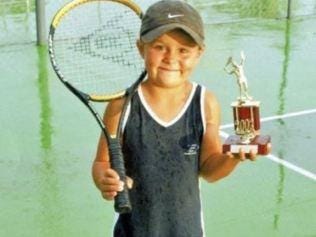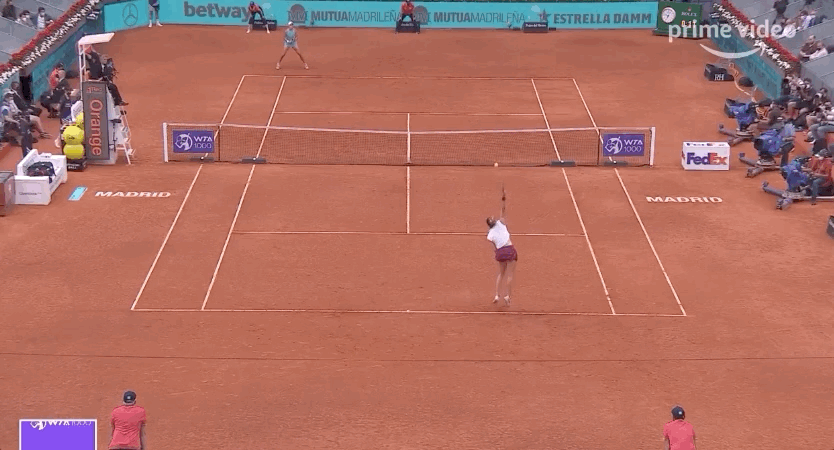Aryna Sabalenka wins the Madrid Open: Tournament Analysis
Sabalenka defeated Barty at the Madrid Open to lift her tenth career title and her first on clay. I've analysed the paths to the final of both players and I've dissected their thrilling finale.
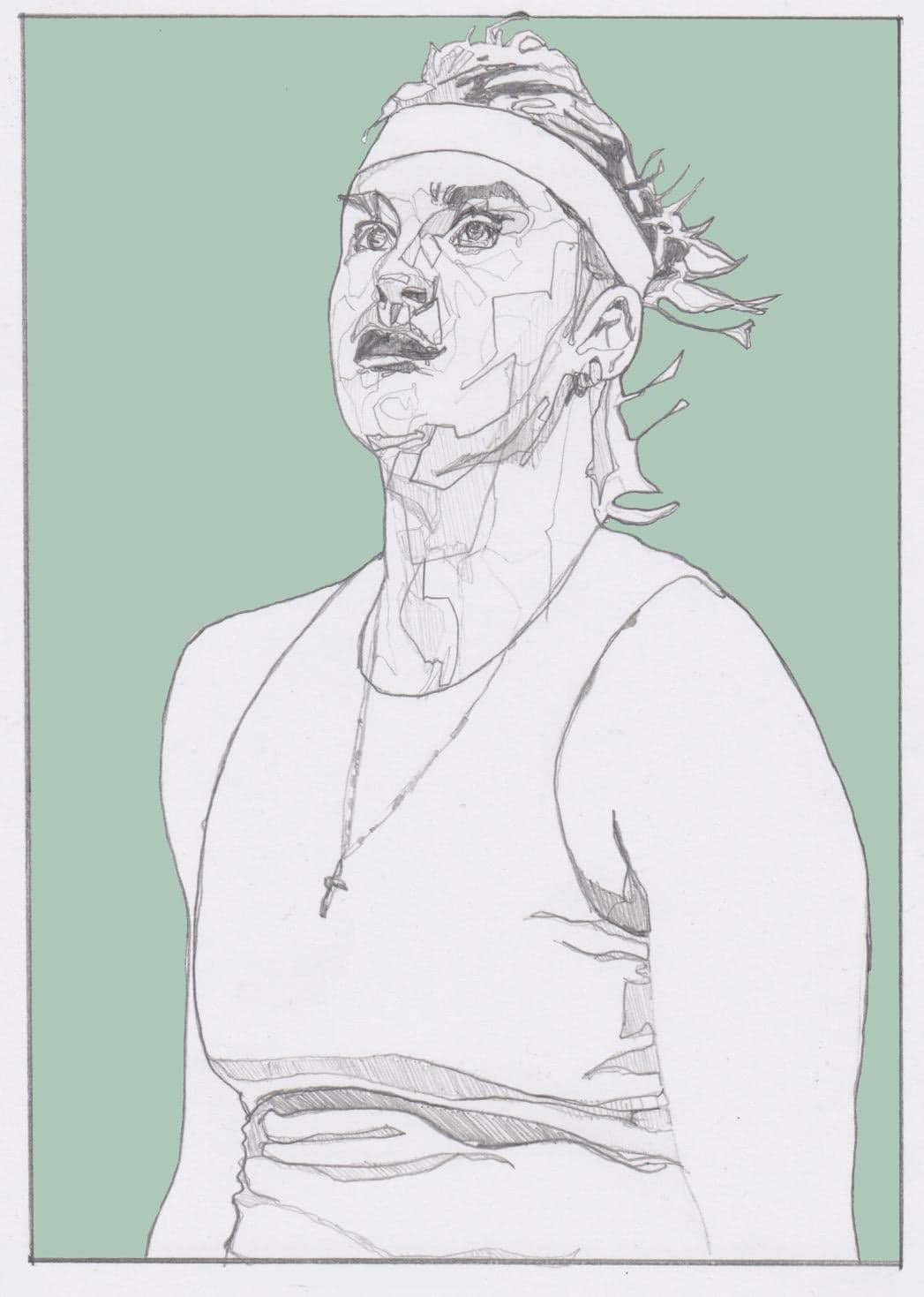
If you enjoy the article, you can support ‘On The Line’ below if you like. Anything would be greatly appreciated.
Last Saturday, Aryna Sabalenka obliterated her way to the Madrid Open title.
She dropped just 17 games going into the final and defeated world #1, Ash Barty, to lift the trophy, handing the Aussie her first bagel set in four years1.
Before 2021, Sabalenka was 18-16 on clay - she has gone 10-1 in the last month alone, having lost to Barty in the Stuttgart final in April. The Madrid Open is her first title on the surface.
Aryna Sabalenka is steadily proving herself a threat whomever, and wherever, she plays.
How did Sabalenka get her revenge against Barty after her loss to her in Stuttgart? What challenges did the two players face along the way?
In the latest ‘On The Line’ article, I analyse:
Barty’s toughest match pre-final against Iga Swiatek2.
Sabalenka’s toughest match pre-final against Daria Kasatkina.
The thrilling three-set Madrid Open finale.
Enjoy!
Barty’s Toughest Match before the Final: Round of 16 vs Iga Swiatek 7-5 6-4
The last two French Open champions.
Ash Barty, on a 13-match winning streak on red clay, and Iga Swiatek, on her own streak of 18 sets on clay, having dropped an average of only 4 games per set.
Swiatek’s accolade must have given her plenty of confidence3 as she showed she could keep up with Barty from the baseline from the get-go. More than keep up actually; Swiatek dominated the extended rallies throughout the match.
When Swiatek did sink her teeth into a rally, she showed she could move Barty around the court, dealing with Barty’s backhand slice relatively well. She was able to win just under half the points where Barty was able to play a non-defensive slice4 - this was the best winning percentage against Barty’s slice of Barty’s last four opponents in Madrid, including Sabalenka5.
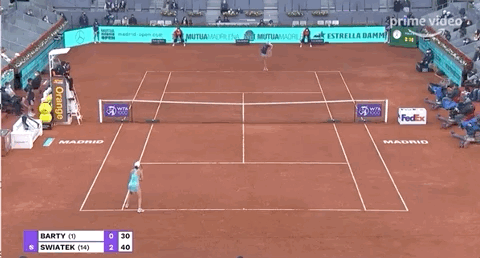
Uncharacteristically, Barty started relatively slow. Her first service game was 18 points long and she made only 44% of her first serves in this game alone, with three double faults to boot.
Things looked promising for Swiatek as she opened up a 3-0 lead.
Barty adjusted, however, to stave off any further breaks. Barty would get one more double fault out of her system in her next game before settling comfortably on serve. She hit an ace or forced an error from Swiatek’s racket using her serve 20 times. A further eight times, she was able to win the point using her following forehand.
Where Barty adjusted her level of aggression accordingly, Swiatek faltered temperamentally.
She went through several serving phases.
The right balance: Swiatek hits three unreturnable serves in her first two service games, enough to complement her dominance in the longer rallies.
Oh dear: Swiatek double faults twice in one game to hand back her lead.
Back to phase 1 for two games.
Channeling Coco Gauff: Swiatek double faults thrice in one game to give Barty the chance to serve it out. Barty jumps at the chance and serves + forehands her way to the first set.
Rolling the first serve in: Clearly conscious of the double faults, Swiatek adjusted by playing safe first serves for the first three games. Barty returned the first 11 serves Swiatek hit in the second set, grabbing the crucial break as a result.
Sidebar as to how Barty fashioned this break, besides making every return in the game. One of the beautiful aspects of Barty’s game is her disguise on the slice backhand.
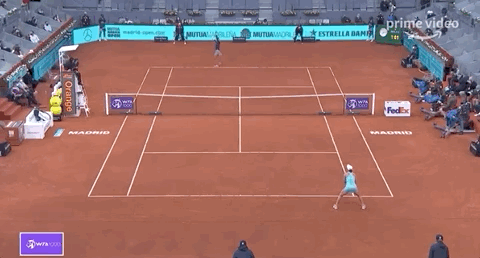
Swiatek moves forward, expecting the slice, and Barty plays the ball deep. Swiatek attempts to pedal backwards but is completely off balance. Barty would close the game with two strong forehands.
Going for more and failing: Swiatek tried to adjust again by going for more on the first serve… but, by then, it had deserted her. She would make 1/11 first serves in her last two service games. She won those games thanks to her power from the baseline but you get the idea of the mental tussle Swiatek was having with her serve.
Swiatek hit an ace or forced an error with her serve only eight times throughout the match. She finished the match with a higher percentage of second serve points won, showing just how ineffective her first serve often was.
Though Swiatek could often outhit Barty, the match was won and lost on the serve. Barty served reliably and effectively, whilst Swiatek’s serving tactics fluctuated from one method to the next.
Given the hype and pressure going into this match, overcoming the Pole was probably Barty’s most impressive feat of the week. This will be a close rivalry in the future but, for now, Barty is just too steady for Swiatek.
Sabalenka’s Toughest Match before the Final: Round of 32 vs Daria Kasatkina 6-3 6-3
Sabalenka dropped an average of 3.4 games per match before the final so take “toughest match” with a pinch of salt.
Nonetheless, Daria Kasatkina got under the skin of Sabalenka at times during their round of 32 match.
Unfortunately though, Kasatkina never fully recovered from a slow start. Sabalenka raced through five of the first six games, finishing the point by hitting a winner or forcing an error 55% of the time. Backhand returns, drop shots, unpredictable forehands; it was all working for Sabalenka.

Kasatkina could only tag along for the ride, controlling the outcome of 18% of the points.
A consummate professional, Daria wasn’t to be disheartened. For all its incredible power, the Sabalenka backhand ebbs and flows and the Russian recognised this, directing the majority of her shots to this wing from thereon-in. Some unforced errors from this wing and some decent serving from Kasatkina gave her a break, a hold and a break point at 3-5 down.
When it mattered most though, Sabalenka slammed down a risky second serve.
Though she took the first set, Kasatkina had planted seeds of doubt.
She was finding depth on her defensive shots and was making it tough for Sabalenka to finish points quickly, with rallies extending past five shots 29% of the time compared to 21% in the first set.
Kasatkina also increased her attack on the backhand.
Kasatkina first set serve direction: FH = 48% / BH = 52%.
Kasatkina second set serve direction: FH = 18% / BH = 82%.
These factors posed a few questions that Sabalenka had mixed results answering.
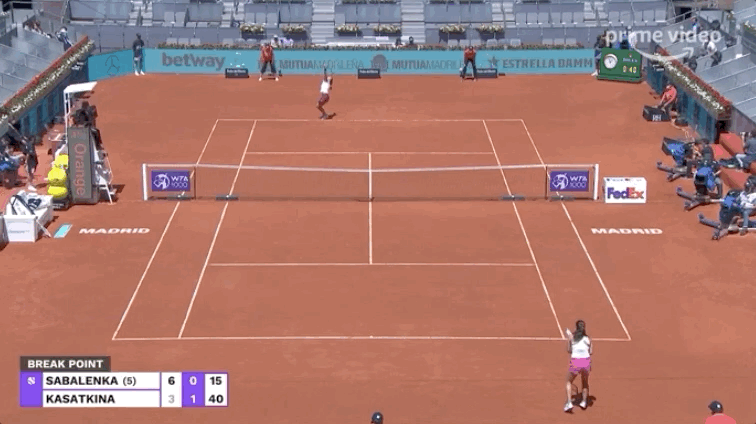
The point above shows her ingenuity on the big points.
In between big points, Sabalenka was a bit spotty. She played some suspect drop shots to cut off some points, winning just one (see above) of six drop shot attempts. The same pattern of solid big points/rubbish small points emerged serving at 4-3, where she chucked in three double faults but survived the game with her trusty forehand.
Disregarding the first 15 minutes or so, Kasatkina put up about as much resistance as she could have hoped for in this match. Decent returning (one ace from Sabalenka and an 82% return rate), some solid defence and an attack on the backhand made Sabalenka a little uncomfortable.
Unfortunately for Kasatkina, Sabalenka is comfortable getting uncomfortable, nowadays. Okay, the drop shots were mainly plop shots. On the whole though, the odd mix-up worked in Sabalenka’s favour when she wasn’t firing on all cylinders and it mattered most…
… and then there were the portions of the match where she was firing on all cylinders. 40 winners in eighteen games.
Despite a hearty fight, it was all too much for Kasatkina.
Is there anyone in the world that can win more than six games against the Belarusian?!
Mutua Madrid Open Final: Aryna Sabalenka defeats Ash Barty 6-0 3-6 6-4
Another match at the Madrid Open for Ash Barty, another exciting narrative!
Ash Barty, the world #1, up against Aryna Sabalenka, probably the most in-form player besides Barty. Cunning variety against brute force.
Let’s dive in!
Set 1 Sabalenka 6-0: Sabalenka bulldozes Barty’s forehand
My first impression watching this set: Sabalenka murdered every ball she got the opportunity to hit. She hit a winner or forced an error 18 times to only three unforced errors so my impression wasn’t completely unfounded.
I was surprised to find out, however, that on her way to bagelling Ash Barty, Sabalenka’s groundstrokes had been significantly slower than her tournament average.
Watching the match back, one thing became clear to me: Sabalenka wasn’t always aiming to put the ball away.
She was aiming for the forehand, resulting in Barty hitting her forehand 66% of the time. If Sabalenka didn’t win the point outright by pressurising the forehand with her serve or return, she would clean up on the next shot by hitting to the exposed backhand wing.

Three more stats support this tactic:
A whopping6 33% of Sabalenka’s rallies extended to five or more shots, suggesting she was comfortable constructing the point with slower, yet heavy shots.
Barty started slow on the forehand, hitting six unforced errors off this wing7. Sabalenka recognised this and doubled down on the barrage.
Barty only got to attempt five non-defensive backhand slices (this calls for an acronym!: NDBS), her lowest number in any set of her last four matches. Even these attempts proved futile - she won only one point where she attempted a NDBS, the only time she’d lost the majority of NBDS points in her last seven sets played.
Couple all of this with the odd drop shot just to remind Barty to stay put behind the baseline… Sabalenka was unplayable.

Set 2 Barty 6-3: Barty finds her range on the forehand, Sabalenka gets in a tactical muddle
First game of the second set. Barty needed to send a statement of intent.


Barty had hit two forehand winners in the first set, now she’d hit two forehand winners in the first five points.
The dynamic of the match completely changed as a result. Sabalenka started to target the backhand wing rather than the forehand wing, with Barty hitting a groundstroke from her backhand wing 55% of the time in the second set.
Give Barty time on the backhand and she’ll slice you to pieces.
She broke Sabalenka immediately, her last two points two short backhand sliced returns that Sabalenka failed to dig out. Barty would finish the set winning 13 of 16 points that included a non-defensive backhand slice.
On the other side of the court, Sabalenka dithered from one tactic to the next, attacking Barty’s backhand from the wrong positions and feeling forced to finish the point quickly.
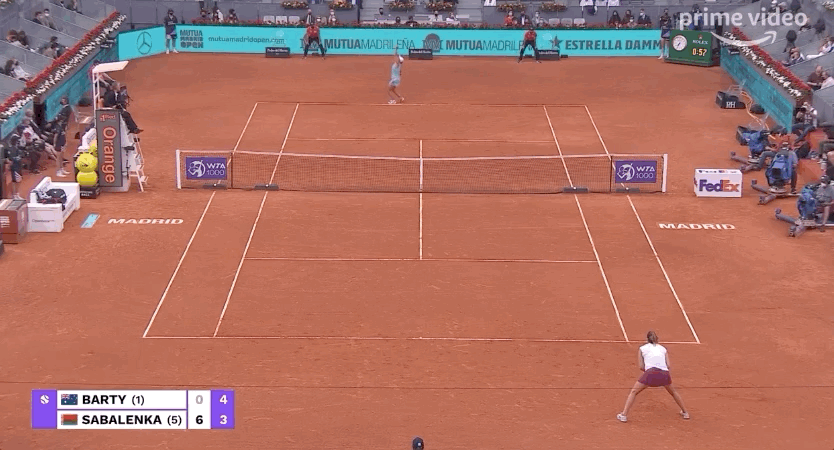
Sabalenka hit 18 unforced errors to Barty’s three. 12 of these unforced errors were in the 0-4 shot range, accounting for over 40% of the points Barty won.
A number of numbers there so, in summary:
Barty had shown she wasn’t going to roll over on the forehand.
Sabalenka changed tac.
Barty had more opportunities to change the dynamic of the point using an NDBS.
Sabalenka, feeling the pressure to finish the points quickly, imploded a little.
Set 3 Sabalenka 6-4: If it ain’t broke…
Going into the third set, the winner should have been a foregone conclusion. Barty had gone 11-1 in deciding sets this year, whilst Sabalenka was on a streak of six deciding set losses, including her loss to Barty in Stuttgart.
Deciding set records? Barty’s red clay winning streak? No clay court titles?
Sabalenka couldn’t have cared less. She showed the world she’s got brains to match the brawn.
She’d started with a winning tactic and she’d changed it, fearing the worst of the Barty forehand - if it ain’t broke, don’t fix it!
In the third set, she wisely reverted back to her initial tactic. Barty hit a forehand on 63% of her groundstrokes, a massive change from the second and only 3% percent off of the first set count.
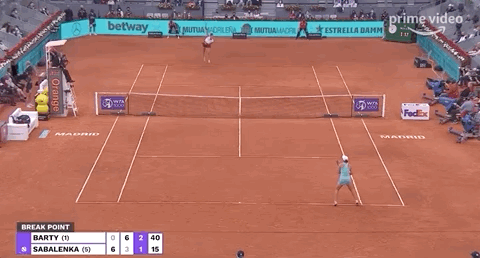
Barty kept up with Sabalenka for eight games, still managing to win the majority of NDBS points, and still hitting a winner or forcing an error more often than she hit an unforced error.
At 4-4, however, Sabalenka won the next eight points. This first one set the tone.

The following point, Sabalenka attacked another return, this time to the backhand. Barty struggled to gain control of the point, looking a little flummoxed by the tactical variation, and she tamely netted a drop shot.
Fear of the return resulted in Barty double faulting for only the thirteenth time in the tournament. Her final service point was the complete opposite as a central first serve was eviscerated.
The set was tight but Sabalenka’s decision to stick to her original game plan won her the biggest points. Sabalenka’s return and a little bit of a poor serving day8 from Barty were the tools required to execute the game plan.
Aryna Sabalenka in Madrid: Tournament Analysis
Throughout the week, Sabalenka had shown she was the player to beat.
She’d destroyed every opponent she’d played, mainly utilising, arguably, the most powerful game in the world with sprinkles of tactical variation.
Barty was almost up to the task. She’d beaten some of the best clay-courters in the world, serving and slicing up a masterclass along the way.
In the end though, Sabalenka’s strategy was too hot for the Aussie to handle. Though Barty potentially played her worst tennis in the final relative to her other matches this week, particularly in her serve, Sabalenka was the catalyst behind her capitulation.
Well done on a superb week Aryna!
If you enjoyed this article, you can click the subscribe button below for weekly updates or you can support the dream by clicking below that. Thanks very much for hanging around this long!
Also, follow me on Twitter (@jackedward1994) and Instagram (@jack221194)!
Garbine Muguruza was the last player to bagel Ash, at the 2017 Canadian Open.
For you ‘On The Line’ faithfuls, you’ll notice I’ve changed the formula up a little bit this week… For two good reasons!
Barty is arguably the most tactically astute player in the game right now and analysing her matches is an absolute joy.
Barty’s road to the final was full of insanely good storylines; an inspired qualifier, two French Open champs, the player with the most Madrid Open titles and the most matches against Barty and the last player to beat Barty on clay, even if it was green.
Or maybe she was just fired up after listening to “Welcome to the Jungle”.
A non-defensive backhand slice is one that Barty has had a fair amount of control over i.e. a neutral or an aggressive slice. Basically, a slice where Barty had the opportunity to go up in the point.
Swiatek 48%, Kvitova 35%, Badosa 45%, Sabalenka 38%.
For the first-strikiest first-striker in the game, this a large chunk of her points won! In sets two and three, these percentages were 9% and 13%, respectively.
Barty had hit four unforced errors against Badosa and seven unforced errors against Kvitova. Relatively, six unforced errors over the course of six games is a terrible performance from Barty. A combination of pressure and not being allowed to dictate from this wing caused the forehand to crumble.
Barty recorded her worst ace rate (three aces) and her worst break point saved rate (3/8) of the tournament. Credit to Sabalenka for bringing out the worst in Barty!







